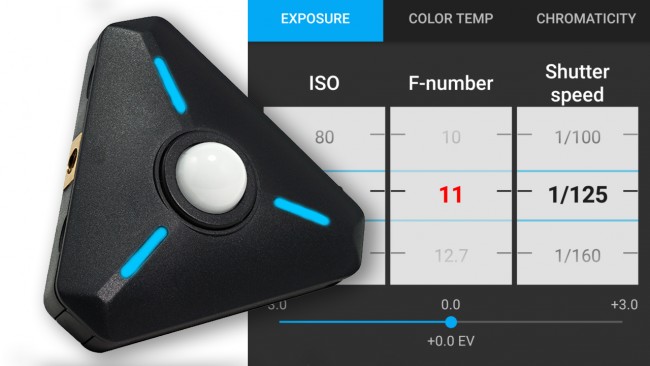By Chris Monlux
More than just a light meter, the Illuminati Wireless Light and Color Meter measures both the light your lights emit and its color temperature. It will even suggest a gel to help unify the color temperature across lights that don’t match. For 300 dollars, it’s a great value and super useful.
The Illuminati meter started out as a Kickstarter product in April of 2017. In just 30 days, the project reached its goal, and since then, Illuminati has been working diligently on the meter. In this review, we test the final production model available for everyone.
The meter offers incident metering for ambient and flash lighting with an exposure meter range of -1 to 18 ev. As any light meter should, it will give you one of the three values needed for setting proper exposure: ISO, shutter speed or aperture. Set the ISO and shutter speed, and it will tell you the aperture. It also offers color temperature metering between 1600 to 20,000 degrees kelvin (K). It connects wirelessly to an iOS or Android device with around a 78-foot range. For more complex setups, you can use multiple meters at a time; there is no limit to the number of meters you can use. Additionally, the Illuminati has a magnet on the back for easy mounting when the situation requires it.
In Use
There are a couple typical uses for a light meter. The first is to get help with exposure, especially for photographers working with a strobe. The Illuminati has a light sensor to trigger a strobe reading, so you know what light you’re working with even when your lighting is not continuous. The next typical use for a light meter is to execute a contrast ratio. It could be that you are trying to recreate a lighting setup used at a prior shoot, or maybe you are trying to set a contrast ratio with a new setup. Regardless, the meter tells you the power of each light in luxor foot candles, so it’s easy to figure out the contrast ratio between two lights.
Going further than a normal light meter, the Illuminati meter also gives the kelvin value of any given light. For us at Videomaker, this allowed us to unify the color temperature across all the lights in our studio. Our studio is mostly 1×1 bi-color soft LED panels. However, we also use a few LED Fresnels that are daylight balanced. Not one of our lights is actually 5600K when balanced for daylight according to the Illuminati meter. Color temperatures ranged from 5350K to 5700K. Since we couldn’t adjust the color temperature of the Fresnels, we matched all our other lights to them.
We shot both before and after balancing our lights’ color temperatures with the Illuminati meter and the results were quite interesting. We tested the change with a Canon C200, Panasonic EVA1 and Panasonic GH4.
Before the color balance, when set to auto white balance, each camera did an alright job at choosing the average color temperature. They generally got pretty close. By contrast, when we manually set the white balance of each camera at 5600K, the image did not look good. The result was very green and not flattering to skin tones. At that point in our test, the average color temperature of the scene metered in at around 5220K. Because we assumed the lights were 5600K and had set the white balance accordingly, we got a worse outcome than auto white balance in the end. However, once we balanced the room to the same kelvin value of 5100K and set each camera to that value, the color being captured was much more accurate than before and looked better than using auto white balance. Without having the Illuminati meter, we might have never known that our lights were so far off from what we thought they were.
NO FUSS, NO TRIAL AND ERROR, JUST A SIMPLE PROCESS THAT GOT OUR LIGHTS DIALED-IN QUICK.
We then needed to set the key and fill lights for our A-roll. We wanted a bit of contrast between the two sides, but nothing super dramatic — just enough to allow for contour and depth. Because the Illuminati has a lux interpretation, we could easily get a reading of the intensity of each light. Turning on each light one at a time, we were able to easily dial-in the desired contrast ratio. No fuss, no trial and error, just a simple process that got our lights dialed-in quick.
Marketplace
To see where the Illuminati Wireless Light and Color Meter fits into the marketplace, let’s look at the Lumu Color and Light Meter, the Sekonic L-858D-U and the Sekonic C-700-U. These meters are all priced between 300 and 1,500 dollars.
The first competitor is the most similar product to Illuminati meter. The Lumu Power Color and Light Meter costs 300 dollars. It also works with an iOS app — but only iOS — and connects via a lightning connection. The big difference between this and the Illuminati is that one is physically connected to a phone and the other is not. The Lumu has exposure, illuminance and color metering for both ambient and flash lighting. It has a measuring range of -4 to 20 EV and a color temperature range of 1500-20,000K. It also has a illuminance range of 0.15-250,000 lux.
Next up is the biggest name in light meters: Sekonic. The Sekonic Speedmaster L-858D-U costs 600 dollars. It has incident metering for ambient and flash. Like the Illuminati, it has an input for framerate and adjustments for shutter angles. The L858D-U has a measuring range of -5 to 22.9 EV and a illuminance range of 0.1 to 2,000,000 lux. When compared to the Illuminati, it’s missing the ability to get a kelvin reading.
Last up is the Sekonic C-700-U SpectroMaster for 1,500 dollars. It also has incident metering for ambient and flash. It has a illuminance range of 1-200,000 lux and can measure color temperature from 1600-40,000K.
Final Thoughts
If you have ever needed a light meter, the Illuminati will do it for you and for a really affordable price. With its ability to tell you the kelvin value of your light, support for an infinite number of meters controlled by a single mobile device, and its easy usability, you might find yourself looking for a reason to buy one.
Illuminati Instrument Corp.
www.illuminatiinstruments.com
$300
STRENGTHS:
- Easy to use
- Indicates color temp in kelvin
SUMMARY:
If you ever wondered how to set your camera’s exposure, a light meter will give you the exact settings to use. Additionally, the Illuminati offers loads of other great video features.
RECOMMENDED USERS:
- Anyone
TECH SPECS:
Type: Incident meter for ambient, flash, and color
Exposure Metering Range: 1 to 1,000,000 lux, -1 to 18 EV
ISO: 3 to 409600
Shutter Speed: 30 to 1/64,000 sec
Aperture: f/0.5 to f/144
Color Temperature: 1600 to 20,000K
Metering Modes
Ambient: Manual or continuous monitoring, flash with sync cord, wireless flash with pre-flash rejection
Flash Sync Outlet: 1/8″ / 3.5 mm jack
Operating Range: Approx. 78.75′ / 24 m
Connectivity: Bluetooth 4.0 (BLE)
Supported Devices:
Apple devices running iOS 8.1 or higher
Android devices running 4.3 or higher
Power: 2 x AAA batteries
Dimensions: 3.1 x 2.8 x 1.2″ / 78 x 70 x 30 mm (including dome)
Weight: 2.2 oz / 62 g (with batteries)
Chris Monlux loves a good light. He is also Videomaker’s Multimedia Editor.







